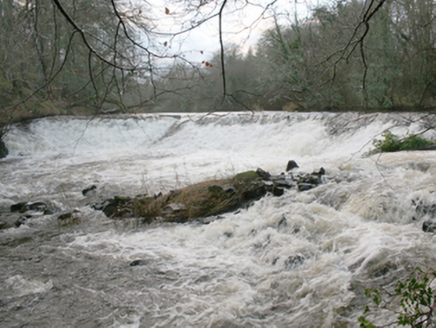Survey Data
Reg No
40823002
Rating
Regional
Categories of Special Interest
Architectural, Technical
Original Use
Weir
Date
1780 - 1890
Coordinates
221638, 421064
Date Recorded
23/06/2014
Date Updated
--/--/--
Description
Weir (on curvilinear-plan) spanning the River Leannan, erected c. 1812, and altered c. 1870 and c. 1930. Possibly incorporating fabric from earlier weir to site. Originally associated with Rathmelton Mills, later Kelly’s Mills (see 40800301-3) adjacent to the south-east. Squared and coursed rubble stone construction to weir. Weir originally built to supply former mill race to the north-east of weir, now out of use. Later sluice mechanism to the west end of mill race, built c. 1930, having reinforced concrete construction and remains of timber sluice gates with steel pulley mechanisms and equipment. Located adjacent to the north-west of Drummonaghan Bridge (see 40800210) and in the rural countryside to the west of Ramelton.
Appraisal
This well-built utilitarian structure was originally built to create a suitable head of water to supply the mill head race to the north, which powered the water wheel or wheels at Ramelton Mills, later Kelly’s Mills (see 40800301-3), located a short distance to the south-east. It represents an interesting structure of some technical and engineering merit, and forms part of a group of related structures associated with the former mills, and is itself an integral element of the extensive industrial heritage of the Ramelton area. The weir survives in relatively good condition and whilst the man-made nature is perhaps under-appreciated, it forms an important part of a group of nineteenth-century structures that were at the forefront of the industrialisation of food processing in this area (which was very important to Ramelton throughout the century). The success of the mill was perhaps owed to its proximity to the port of Ramelton, from where produce was exported, particularly to the Clyde and Mersey areas of Britain. This weir probably originally dates to c. 1812, the date when the associated mill was established. However, it is likely that this location may have been the site of earlier mill or mills (there are only limited locations where a mill was possible before c. 1750), and it may incorporate earlier fabric.













